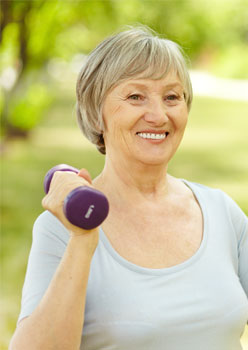Exercise to Strengthen our Bones this World Osteoporosis Day

Exercise for Prevention and Management
With osteoporosis affecting more than 1.2 million nation-wide, Exercise & Sports Science Australia (ESSA) wants to remind Australians this World Osteoporosis Day that exercise should be included as an important part of care in the prevention and management of osteoporosis symptoms.
'With over a half of women, and a third of men, over 60 being affected by osteoporosis, it is important to make sure all Australians know the valuable benefits that exercise can have on managing and even reversing the symptoms of osteoporosis, as well as reduce further risks, such as falls," explains ESSA Chief Executive Officer, Anita-Hobson Powell.
A recent Osteoporosis Australia report estimates the brittle bones of Australians aged 50 and over is expected to cost $3.1 billion in 2017. This will then climb to $21.9 billion by 2022, with a fracture occurring every 2.9 minutes. Research shows that strength-based exercise programs are as effective, if not more, as prescription drugs at preventing osteoporosis fractures and strengthening bones.
As bones become thinner and less dense, even a minor bump or fall can cause a serious fracture. Osteoporosis usually has no symptoms until a fracture occurs – this is why it is often called the -silent disease'.
A recent clinical trial involving 101 older women found that a strength-based exercise program increased their spinal bone mass by an average of 5 per cent and their hip bone mass almost 2 per cent. In comparison, a recent pharmaceutical trial saw bone density improvement in the spine increase by 6 per cent, and 3 per cent in the hip.
'It is important to know the areas and bones affected by osteoporosis and the severity before beginning exercise to ensure your accredited exercise professional can tailor a safe program that is going to meet your specific needs," discusses Accredited Exercise Physiologist, Carly Ryan.
'Not only can exercise strengthen bones and muscles, improve balance and in turn reduce the risk of falls and fractures, recent studies have seen exercise significantly increase bone density, reducing risk of fractures by up to 95 per cent. This is better than bone restoring medications which can cut hip fractures by just 40 per cent," continues Ms. Ryan.
Things to remember:
Start an exercise program under the supervision and guidance of an exercise expert knowledgeable and qualified to prescribe exercise to those with osteoarthritis such as an Accredited Exercise Physiologist.
High-impact exercises or exercises that involve explosive movements should be avoided.
Exercises involving loaded rotation and flexion should be avoided.
Weight bearing, muscle strengthening and balance training activities are best to increase the strength of bones and prevent falls.
Begin lightly, and gradually increase the amount of weight and resistance.
You can find your local Accredited Exercise Scientist or Accredited Exercise Physiologist here.
https://www.ncbi.nlm.nih.gov/pubmed/26243363
MORE



